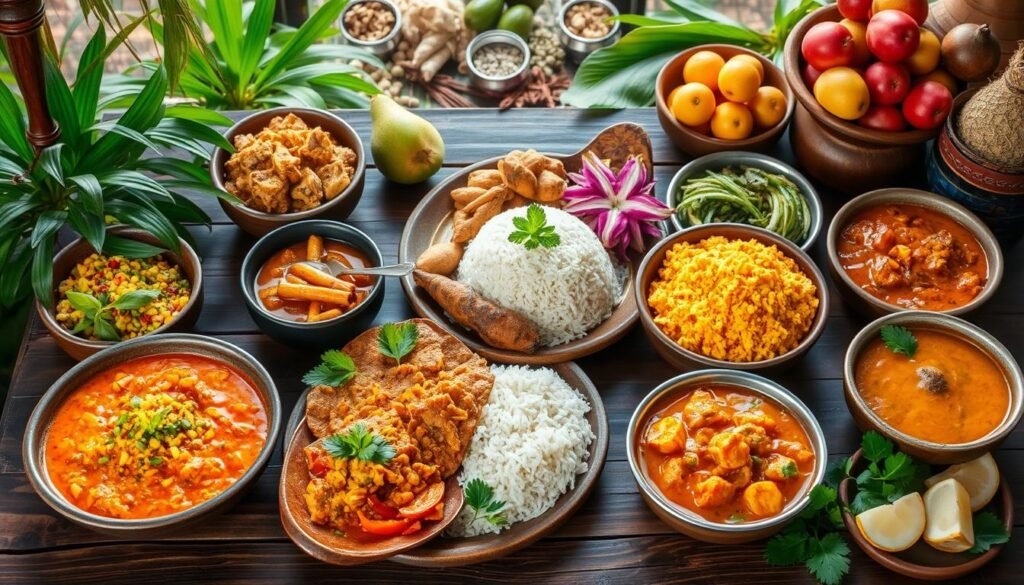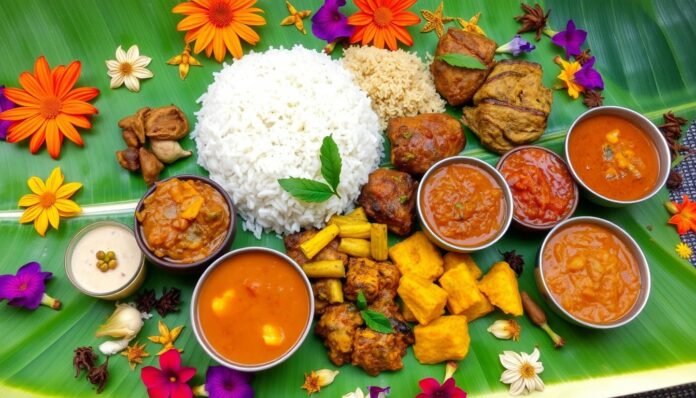Welcome to Sri Lankan cuisine, a world filled with bold flavors and rich diversity. After a 10-day journey in this beautiful island nation, we discovered many dishes. These dishes use fresh ingredients and traditional cooking techniques. You’ll find everything from versatile Hoppers to irresistible Kottu at street stalls. Each dish provides a unique taste of Sri Lanka’s culinary wealth.
Imagine enjoying a robust Fish Curry made with tuna or mackerel. Alongside, sip on strong Ceylon black tea. For dessert lovers, Watalappan is a treat. It combines coconut milk, cashew nuts, and warm spices into a delightful sweet. This article invites you on a journey through traditional Sri Lankan recipes. Explore why these recipes are loved by many!
Key Takeaways
- Sri Lankan cuisine features a variety of dishes that can be enjoyed any time of day.
- Curry leaves play a crucial role in enhancing flavor and offer health benefits.
- Fish Curry is a staple, typically made with tuna or mackerel.
- Desserts like Watalappan showcase the cultural blend of Sri Lankan and Malaysian influences.
- Sri Lanka is renowned for its flavorful teas, perfect for pairing with meals.
Introduction to Sri Lankan Cuisine
Sri Lankan cuisine is rich with diverse flavors. It reflects the island’s mix of ethnicities and its location. The Sinhalese, making up 75% of the population, influence the food deeply. Their Buddhist beliefs shape traditional recipes, rooted in history and community.
The cuisine’s foundation is built on staple ingredients. Rice is key, with over 15 varieties grown locally. Coconut is another essential, used in everything from sambal to sweets. A variety of spices like cinnamon and cardamom add layers of flavor to dishes.
“Rice and curry” is the backbone of meals here. This combination includes rice with different protein curries. Seafood, chicken, or lamb are common, reflecting the island’s culinary variety. Spicy dishes, like Jaffna curry with goat or seafood, are popular. They use one of the 60 chili pepper types grown locally.
Food holds deep cultural importance in Sri Lanka. Side dishes like pappadum or dhal curry are staples. They enhance the communal dining experience. Balance is key in these recipes. They ensure no ingredient dominates the dish.
To sum up, Sri Lankan cuisine blends history with local tastes. This creates meals that are tasty and full of cultural meaning.
Popular Sri Lankan Food: An Overview
Sri Lankan food is a mix of flavors from different cultures. Hoppers are a must-try. These are fermented rice pancakes, often with egg or spicy sambol. They show the great balance of tastes in the local cuisine.
Kottu is famous with both locals and visitors. It’s made from chopped roti, veggies, meat, and spices. You can find it at street vendors, especially at night.
Fish curry is another main dish. The type of fish varies, using what’s available. Coconut milk and spices make these dishes rich and flavorful. They’re a key part of meals here.
- Rice and Curry: A typical meal involves a meat dish with several veggie curries.
- Batu Moju: A tangy eggplant pickle, great as a side dish.
- Sri Lankan-style pancakes: These breakfast treats can have various fillings.
- Koththu Roti: A versatile dish, great for easy Sri Lankan recipes.
Sri Lankan food has lots of vegetarian dishes like mallungs and baby jackfruit curry. These flavorful curries use local produce. Snacks, or “short-eats,” include mutton rolls and fish cutlets. They’re great for tasting different flavors.
Kiri bath and Jaffna crab curry are examples of the country’s wide food range. Exploring these dishes introduces you to rich flavors and textures. They’re perfect for sharing with family and friends.
Recipes for Sri Lankan Food: A Culinary Journey
Starting your journey in cooking Sri Lankan food brings you to rich flavors and aromatic spices. Each recipe showcases the island’s unique culinary tradition. It lets home cooks make well-loved dishes. To do good, you must grasp the cooking methods and key ingredients.
How to Prepare Authentic Sri Lankan Dishes
Making real Sri Lankan food is more than just recipes; it’s loving the flavors. Try Pittu, a breakfast favorite. It’s made with coconut and rice flour, offering a gluten-free meal. Steam it for 5-6 minutes, and you’ll get a fluffy dish for 6-8 people.
Pol Roti with Pol Sambol is another must-try. Flour, shredded coconut, and green chillies mix for a unique taste. This careful preparation turns simple meals into memorable ones.
Dessert fans should try Wattalapam Jelly Pudding. Coconut milk, egg, jaggery, and agar agar make a creamy pudding. Each recipe shares Sri Lankan cuisine’s heart, inviting creativity in using traditional flavors.
Ingredients Commonly Used in Sri Lankan Recipes
Knowing what ingredients are key in Sri Lankan cooking boosts your cooking game. Here’s a list of common ones:
| Ingredient | Uses |
|---|---|
| Coconut | Used in various forms such as grated, milk, and oil; adds richness to dishes. |
| Jaggery | Natural sweetener for desserts and snacks; enhances flavor complexity. |
| Rice Flour | Base for many traditional dishes like Pittu; gluten-free choice. |
| Spices | Includes cardamom, cinnamon, and curry leaves; vital for aromatic flavors. |
| Vegetables | Mixed into various dishes, creating nutritional balance and flavor. |

Each ingredient is key in making true Sri Lankan meals. They encourage cooks to try new things. As you explore Sri Lankan recipes, you’ll discover a world of tastes, colors, and methods. Enjoy this food adventure and let every dish share its story!
Spicy Sri Lankan Dishes to Try
Sri Lankan cuisine is known for its spicy Sri Lankan dishes. These dishes bring bold flavors and aromatic spices to the table. Favorites include deviled prawns with a fiery kick and spicy beef curry that adds warmth. All these recipes show the deep flavor traditions of traditional Sri Lankan recipes.
Kottu roti is a must-try street food. It’s made from shredded roti mixed with vegetables, meat, soy sauce, and spices. Then, there’s lamprais, which blends Dutch cuisine influences with boiled eggs and mixed meats, all steamed in a banana leaf.
Dhal curry is a beloved Sri Lankan dish, made with red lentils cooked in coconut milk and spices. It’s a perfect example of the best Sri Lankan recipes, mixing spice and creaminess. Mallung adds to the meal with its chopped greens and fresh coconut.
The eggplant moju is great for those looking to add spice to their cooking. It uses vinegar and mustard seeds for a tangy taste. You’ll also find regional dishes like green jackfruit curry (polos) and peppery fish ambul thiyal. Each has its unique place in Sri Lanka’s cuisine.
To dive deeper into Sri Lankan cooking, explore these cultural influences and recipes. You’ll find remarkable flavors and creative uses of spice that set Sri Lankan food apart.
Easy Sri Lankan Recipes for Beginners
Starting with Sri Lankan cooking is very exciting. These recipes mix traditional tastes with easy steps. They’re great for quick dinners, making the rich flavors of Sri Lanka easy for everyone.
Simple and Delicious: Perfect for Weeknight Dinners
The cookbook “Rambutan: Recipes from Sri Lanka” shares over 80 easy recipes. It has everything from coconut dal with kale to pickled pork curry for families. And for smaller meals, there’s a tasty Sri Lankan turmeric omelette.
Think about making chicken curry for its unique taste. The cookbook’s author made it over four thousand times! It shows how much people love it. For richness, add full-fat coconut milk, especially in chicken curry.
Chicken with bones makes curry tastier because bones add more flavor. If you prefer no bones, go for red meats like chicken thighs. Spices like coriander, cumin, and cardamom are key. Try Rani or Wijaya brands for a real taste.
| Recipe Name | Servings | Core Ingredients |
|---|---|---|
| Coconut Dal with Kale | 4 | Coconut milk, kale, lentils, spices |
| Pickled Pork Curry | 4 | Boneless pork, vinegar, spices |
| Sri Lankan Turmeric Omelette | 1-2 | Eggs, turmeric, spices |
How you cook is as important as the ingredients. These recipes teach essential skills and build kitchen confidence. From curries to omelettes, they let anyone capture the spirit of Sri Lankan food. And that means enjoying delicious meals easily.
Conclusion
Cooking Sri Lankan food at home is both fun and rewarding. You get to use spices like cinnamon and cardamom. Plus, coconut milk adds a rich flavor to the recipes. These ingredients reflect Sri Lanka’s culinary tradition.
Trying out these recipes makes your kitchen a place of joy. You can cook dishes like rice and curry or Kottu Roti. Each dish helps you explore the island’s culture. You’ll not only learn new recipes but also enjoy a great hobby.
Add Sri Lankan flavors to your meals and watch your dining table become a source of happiness. Cooking these dishes lets you connect with a unique culture. It’s about more than food; it’s about bringing people together. So, start cooking and enjoy the journey!
